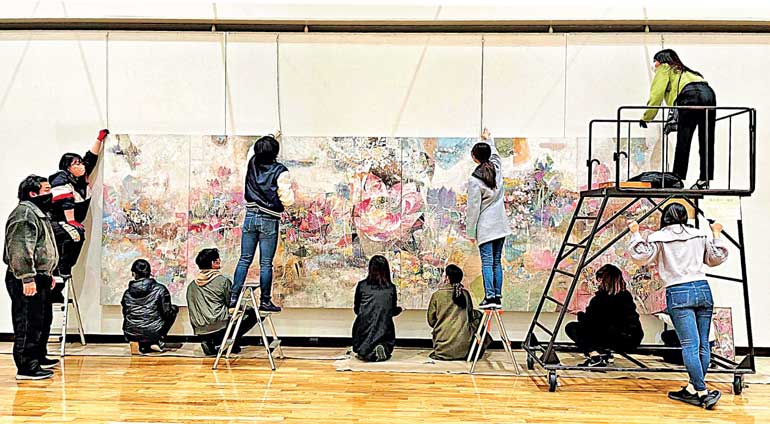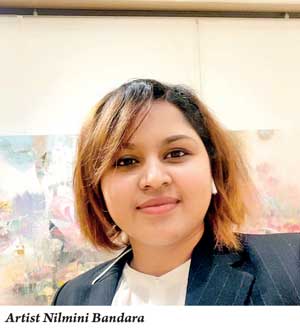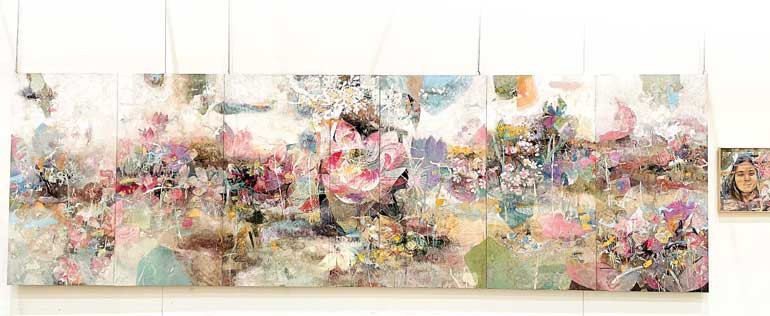Sunday Dec 07, 2025
Sunday Dec 07, 2025
Saturday, 2 July 2022 00:00 - - {{hitsCtrl.values.hits}}
 Artist’s friends giving her a helping hand to hang her major work at the graduation show
Artist’s friends giving her a helping hand to hang her major work at the graduation show
 By Prasad Abu Bakr
By Prasad Abu Bakr
Nilmini Bandara is a local artist undergoing postgraduate studies in fine arts and living in Japan. Though she left our shores over two years ago and has gone through the initial stages of her higher university curriculum, her ‘heart of the matter’ still lingers back here at home in Sri Lanka, especially during these difficult periods of time. Since her studies include using of many indigenous materials, methods and techniques that’s unique to Japan, Nilmini has woken up to the fact that re-thinking along those same traditional lines can help local artists to get over their plight of having to spend dearly in obtaining imported raw materials at exorbitant rates towards practicing and keeping their profession alive.
Taking into account the high cost of artist materials in Sri Lanka owing to the present economic crisis and limited possibilities to import goods including artist materials, Sri Lankan artist Nilmini Bandara says that it is about time that local artists travelled back in time to discover and learn more about the many indigenous methods and materials that were used by local artists in the times gone by.
“This may help artists to go about practicing their profession unhindered while developing new methods and styles to go along with the all new experience of preparing their own pigments and base materials (like handmade paper as an example) or base materials hand made using natural fibres and woven fabrics on which one could create images painted using a naturally produced colour palette and other pigments taken from numerous sources such as barks of different trees largely available in the wild and different shades of earth available in different parts of the country.”
Artist Nilmini Bandara is carrying out further research following her postgraduate studies in fine arts at the Sojo University in Japan where she successfully completed her course in Fine Arts, in addition to which she was presented the highest marks for her 1st class degree for her creative and research work, which is a unique achievement by a student. During her years studying at the university, Nilmini discovered many novel methods that were traditional Japanese techniques to which she was a novice.
During her student years in Sri Lanka she used to dream of an era when she will be able to create visual images mixing beds of traditional Japanese flowers like Sakura, that bloom only for a few days during spring each year, alongside other varieties like iris, peonies or poppy mixed along with our own varieties of blooms such as lotuses. “I never thought that one day I would create such a painting, which I did; it was no strange occurrence but a pure coincidence during my graduation learning years at the art faculty of the Sojo University where I had to practice and undergo many creative exercises such as the ‘Nihonga’ method (a general term for traditional Japanese painting). Now in common use, this term originated during the Meiji period, to distinguish Japanese painting from Western-style oil painting. Nilmini, not only managed to master this traditional art form with extreme success but also created her dream image depicting a combination of traditional varieties of flowers such as Sakura sitting beside our own Lotus flowers from Sri Lanka. (See picture)
This traditional Japanese artistic exercise is created using a combination of many home-based raw materials, which contrasts with paintings created using the Western material such as oil or acrylic on canvas which are mostly made of artificial ingredients. The Nihonga technique contrarily makes use of raw materials made out of nature-based products such as Washi, a traditional Japanese paper. The term is used to describe paper that uses local fibre, processed by hand in the traditional manner. Washi is made using fibres from the inner bark of the gampi tree, the mitsumata shrub, or the mulberry bush and mineral pigments created by combining and heating naturally occurring elements. They include ultramarine and spinel pigment that belongs to different classes of non-organic compounds combined with a binding solution called Nikawa glue, a water based liquid.
“I consider it a great opportunity to have been able to participate in this traditional exercise by participating and creating artworks based on indigenous methods using traditional home based materials,” says Nilmini stressing that it is all done in a very meditative spirit exerting a lot of discipline all through the process of working on such paintings.
Artist Nilmini Bandara contemplates on the art scene back home here in Sri Lanka even though she lives in Japan and drifts into thought as to why our artists and mostly art students do not make use of the many natural materials and methods that were once a hallmark of this nation’s historical past, as she recalls how the many artists who dwelled in the royal court or palaces of this island and who were appointed by the many kings during the period of each one of them, to carry out certain projects most of which are still seen and talked about even today.
“Most such work were executed using locally produced colour pigments made mostly out of different textures of earth, crushed and powdered stone and ground extracts taken from barks of different tree trunks, branches, and roots and other woody plants, leaves and flowers. Likewise local artists should be able to make their own palette of colours using certain indigenous materials and methods,” states the artist who says she hopes to carry out such experiments one day upon returning back home.

Graduation work submitted for Master’s degree (2021), titled (Water Angel) done using indigenous base materials including pigments – Torinoko Paper, Nikawa, mineral pigments including Gold and Silver leaf, sized – 187 cm x 595 cm
This is a most important thought of an idea that suits these times when we in Sri Lanka are suffering many shortcomings that are hindering the progress of many other local industries too, and art being a booming field in recent times it is not surprising to notice a downward trend building up owing to the shortage of materials such as canvas, oil, acrylic and other paints or raw materials and tools which are mostly imported.
According to artist Nilmini Bandara and her observations while spending her time in Japan, she came to learn that even world renowned Japanese artists such as Takashi Murakami (an internationally recognised Japanese contemporary artist who works in fine arts media as well as commercial and is known for blurring the line between high and low arts as well as co aesthetic characteristics) or Yayoi Kusama (another internationally recognised Japanese contemporary artist who works primarily in sculpture and installation, but is also active in painting, performance, video art, fashion, poetry, fiction, and other arts) are both versatile regarding the kind of raw material they use in their creations which includes many types of indigenous materials which in return enhances their creativity and has earned them pride of place in the sphere of fine arts globally.
Nilmini has also contributed in many ways towards enhancing her own learning years in Japan by adhering to her seniors such as artist Kingsley Gunatileke, during her learning years in Sri Lanka, who taught her the finer points and importance of graphic designing and its impact on other related subjects within fine arts such as painting and illustration; likewise, she says that the influence she received through all the advice she received from Professor Kayoko Kusumoto who is a well-known figure in sculpture at the university, who also advised Nilmini to always follow her instincts and stick to the path she wants to learn and build her career upon.
Professor Kenji Nakamura who is a well learned expert on the subject of Nihonga at the Sojo University together with Professor Sato Wakako both who helped her towards building up knowledge and awareness in her chosen field of studies and research and on the many aspects of the uses of indigenous and traditional raw materials fittingly into today’s context of fine arts, all which went a long way towards supporting Nilmini to achieve her goals during her learning years in Japan.
Nilmini Bandara says that involvement in research and learning under those many teachers not only made a difference to her ultimate achievements enabling her to win many awards and medals at various exhibitions and competitions. Nilmini had the privilege of earning praise and accolades following her participation at the well-known Japanese Fine Arts Exhibition ’Nitten’ (Nihon bijutsu tenrankai), an exclusive Japanese art exhibition established in 1907. The exhibition consists of five art faculties: Japanese Style and Western Style Painting, Sculpture, Craft as Art, and Sho (calligraphy). She is also the recipient of awards consequently for two years by participating at the Nishunten art exhibition in Tokyo. Her participation in the 76th Kumamoto Prefectural Museum exhibition won her the Art Association Award and the Award for the Best Entry.
Amidst all her achievements and a clear path opening up for more future achievements during her future stay in Japan, her humble appeal to fellow members of the artistic fray here in her homeland needs to be praised, her concern and encouraging attitude towards setting an example by sharing her profound experience with many of her fellow artist back here at home should be treated as an eye opener to all local artist taking into consideration how artist in Japan and probably globally are moving towards expanding their career horizons by using indigenous materials, homegrown ideas and mostly moving away from hackneyed brush on canvas trends towards more refreshing off the beaten track ideas.